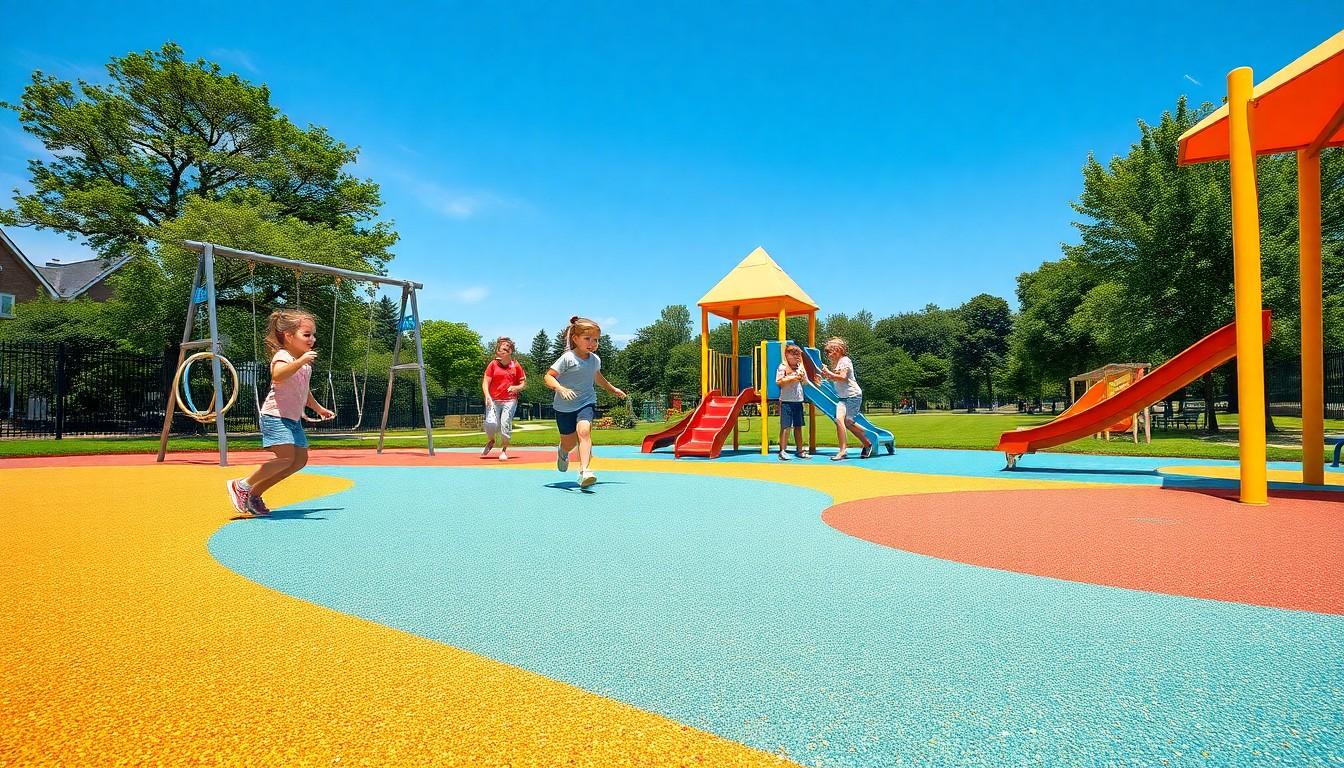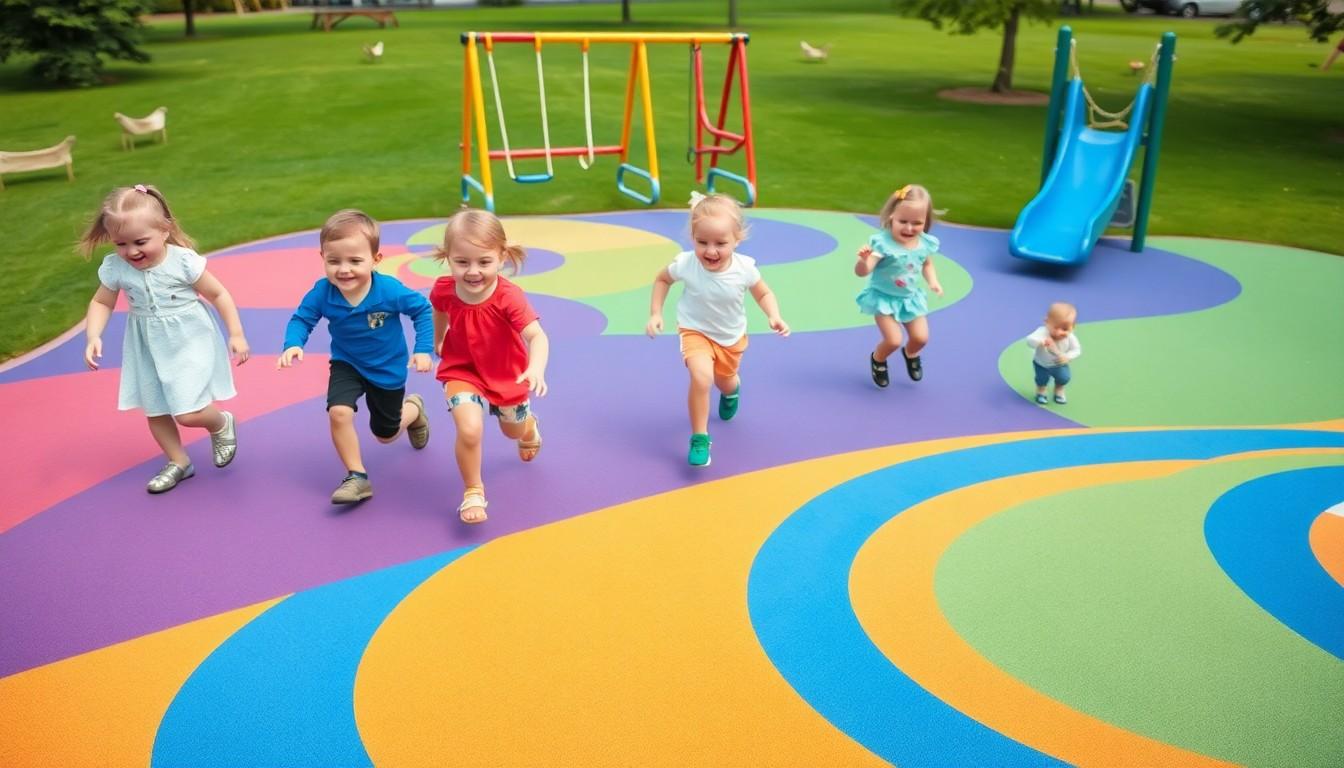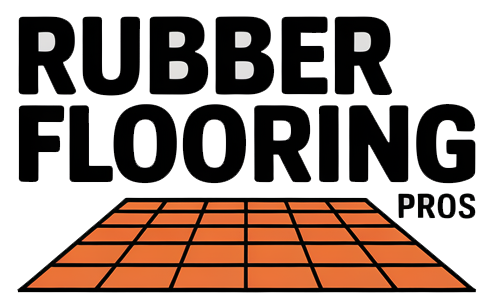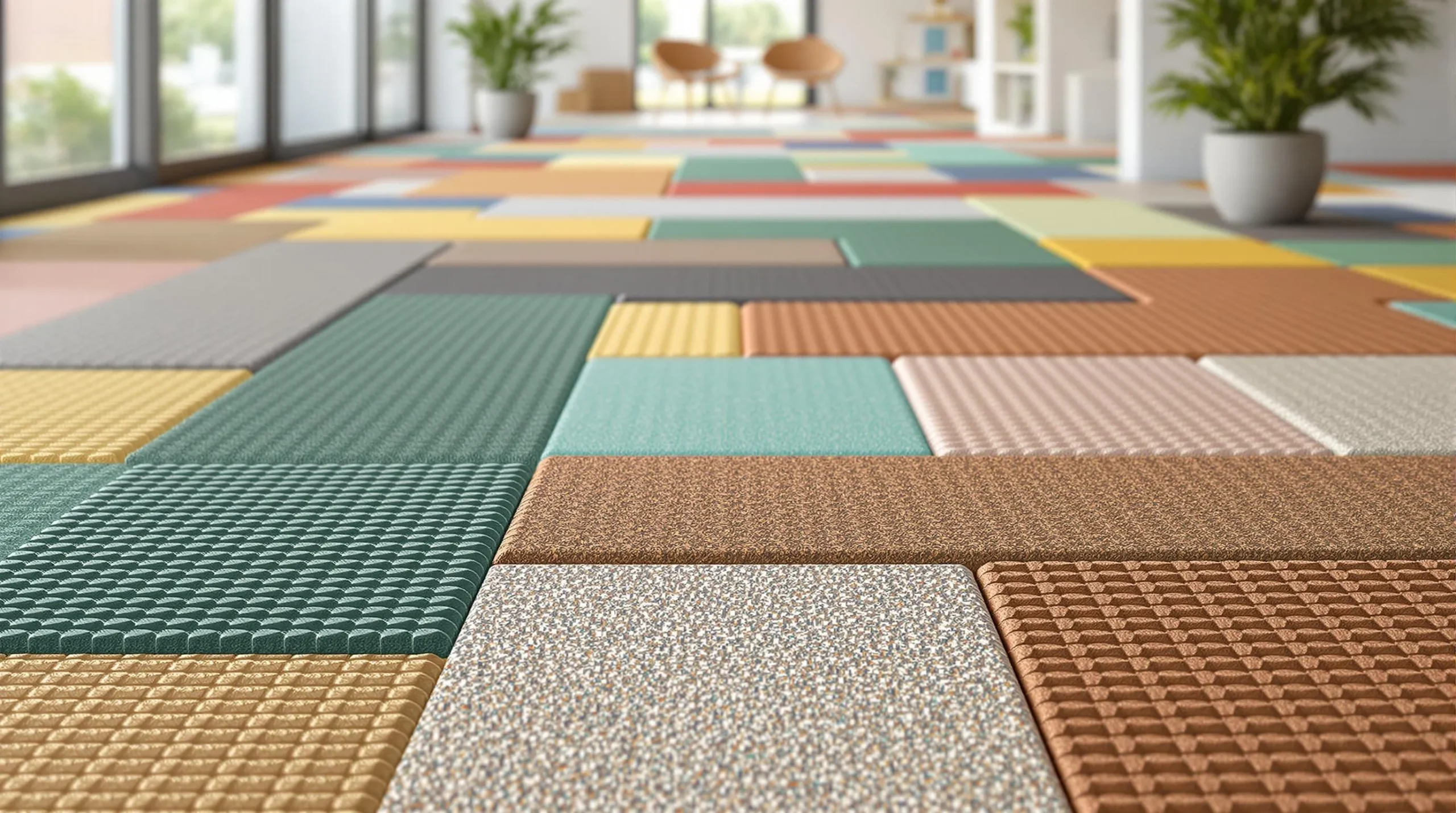When it comes to playground safety you can’t compromise on quality flooring. Playground rubber flooring has become the gold standard for creating safe play spaces where children can run jump and explore without fear of serious injury.
Your choice of playground surfacing plays a crucial role in preventing accidents and reducing the impact of falls. Modern rubber flooring solutions offer superior shock absorption excellent durability and come in vibrant colours that’ll make any play area more inviting. They’re also eco-friendly often made from recycled materials making them a sustainable choice for your playground project.
Key Takeaways
- Playground rubber flooring provides superior safety through impact absorption, protecting children from falls up to 3.5m depending on the material type and thickness
- Three main types are available: rubber tiles (50x50cm), rubber mulch (loose-fill), and rubber roll/pour surfaces, each offering different installation complexity and durability levels
- The material demonstrates excellent weather resistance, withstanding temperatures from -30°C to +70°C, and maintains slip resistance in both wet and dry conditions
- Initial costs range from £45-120 per square metre, but long-term value is achieved through durability (8-10 years lifespan), reduced maintenance needs, and lower insurance premiums
- Environmental benefits include high recycled content (up to 95%), significant CO2 reduction, and sustainable manufacturing processes, making it an eco-friendly choice for playgrounds
What Is Playground Rubber Flooring?
Playground rubber flooring consists of impact-absorbing surfaces designed specifically for children’s play areas. These specialised surfaces transform recycled rubber materials into safe protective flooring that meets strict safety standards for fall protection.
Types of Rubber Flooring Materials
Playground rubber flooring comes in three primary formats:
- Rubber Tiles: Interlocking squares measuring 50x50cm with thicknesses ranging from 25mm to 100mm
- Rubber Mulch: Loose-fill shredded rubber pieces sized between 2-20mm for flexible coverage
- Rubber Roll/Pour: Continuous rubber sheets available in 1.25m widths or poured-in-place surfaces
Each material type offers distinct advantages:
| Material Type | Fall Height Protection | Installation Complexity | Durability (Years) |
|---|---|---|---|
| Rubber Tiles | Up to 3m | Medium | 8-10 |
| Rubber Mulch | Up to 3.5m | Low | 5-7 |
| Roll/Pour | Up to 3.2m | High | 10-15 |
Common Installation Methods
The installation process varies by material type:
-
Tile Installation
- Clean level surface preparation
- Adhesive application on subbase
- Interlocking tile placement
- Edge securing with pins
-
Mulch Application
- Excavation of designated area
- Geotextile membrane laying
- Loose-fill distribution
- Depth monitoring system setup
- Base layer preparation
- EPDM rubber mixing
- Surface pouring
Safety Benefits of Rubber Playground Surfaces

Rubber playground surfaces deliver essential safety features that protect children during play activities. These specialised surfaces combine advanced materials with innovative design to create protected play environments.
Impact Absorption Properties
Rubber playground surfaces absorb up to 80% of impact force from falls through their cushioned layers. The material’s composition includes specially engineered rubber granules bonded with polyurethane to create surfaces that meet BS EN 1177 safety standards. Critical fall heights range from 1.5m to 3m, depending on the rubber thickness:
| Rubber Thickness | Maximum Fall Height Protection |
|---|---|
| 40mm | 1.5m |
| 50mm | 2.1m |
| 75mm | 2.5m |
| 100mm | 3.0m |
Slip Resistance Features
Rubber playground surfaces maintain grip in both wet and dry conditions with a textured surface pattern. The material’s coefficient of friction measures between 0.6-0.8, exceeding the minimum safety requirement of 0.5 for playground surfaces. Key slip-resistant characteristics include:
- Textured granules creating micro-channels for water displacement
- UV-stabilised surface maintaining grip properties in sunlight exposure
- Temperature-resistant compounds preventing surface degradation from -30°C to +70°C
- Cross-linked polymer structure enhancing surface tension for improved traction
- Light rain conditions
- Morning dew accumulation
- Post-cleaning moisture
- High-traffic play zones
Key Factors When Choosing Playground Rubber Flooring

Selecting the right playground rubber flooring requires careful consideration of multiple factors that affect performance and longevity. Understanding these key elements ensures the installation meets safety requirements while providing value for investment.
Durability and Weather Resistance
Playground rubber flooring withstands intense daily use through specialized manufacturing processes and materials. Premium rubber compounds resist UV damage, maintaining colour vibrancy for 8-10 years with proper installation. The material demonstrates resilience in temperatures ranging from -30°C to +70°C, protecting against:
- Freeze-thaw cycles that cause surface cracking
- UV radiation that leads to colour fading
- Heavy foot traffic in high-use zones
- Impact from playground equipment
- Moisture penetration during wet conditions
Maintenance Requirements
Regular maintenance extends the lifespan of rubber playground surfaces through simple procedures. The maintenance schedule includes:
Daily Tasks:
- Remove debris like leaves, sticks or litter
- Check for loose edges or seams
- Inspect for signs of vandalism
- Pressure wash surfaces to remove dirt buildup
- Examine drainage systems for blockages
- Test impact absorption in critical fall zones
- Deep clean with approved cleaning agents
- Assess surface integrity
- Repair minor damages before they expand
| Maintenance Type | Frequency | Time Required |
|---|---|---|
| Basic Cleaning | Daily | 15-20 mins |
| Deep Cleaning | Monthly | 2-3 hours |
| Full Inspection | Annually | 4-6 hours |
Cost Considerations
Playground rubber flooring represents a significant investment that varies based on material type, installation method and project scope. Understanding both initial costs and long-term value helps make informed decisions for playground surfacing projects.
Initial Installation Expenses
Initial costs for playground rubber flooring range from £45 to £120 per square metre, depending on several factors:
- Material Selection:
- Pour-in-place rubber: £85-120/m²
- Rubber tiles: £65-95/m²
- Rubber mulch: £45-75/m²
- Site Preparation:
- Base excavation: £15-25/m²
- Drainage systems: £20-35/m²
- Sub-base installation: £25-40/m²
- Professional Installation:
- Labour costs: £30-50/m²
- Equipment rental: £500-1,500 per project
- Site access considerations: Additional £10-20/m² for difficult access
Long-Term Value
Rubber playground flooring delivers substantial returns on investment through multiple cost-saving benefits:
- Durability Metrics:
- Lifespan: 8-10 years for premium surfaces
- UV resistance: Maintains integrity for 5+ years
- Impact resistance: Retains 90% effectiveness for 7+ years
- Maintenance Savings:
- Annual maintenance costs: £2-4/m²
- Repair frequency: 50% lower than traditional surfaces
- Cleaning requirements: 30% less time compared to loose-fill materials
- Safety Benefits:
- Insurance premium reductions: 15-25%
- Reduced injury-related expenses
| Cost Factor | Pour-in-Place | Rubber Tiles | Rubber Mulch |
|---|---|---|---|
| Initial Cost/m² | £85-120 | £65-95 | £45-75 |
| Installation/m² | £40-60 | £30-45 | £20-35 |
| Annual Maintenance/m² | £2-3 | £3-4 | £2-4 |
| Expected Lifespan | 8-10 years | 7-9 years | 5-7 years |
Environmental Impact
Playground rubber flooring demonstrates significant environmental benefits through its sustainable manufacturing processes and eco-friendly materials. The environmental considerations extend from production to end-of-life disposal, making it a responsible choice for playground surfaces.
Recycled Material Options
Playground rubber flooring incorporates recycled materials in several forms:
- Recycled tyre rubber comprises 90% of the base layer materials, repurposing 2,500-3,000 used tyres per playground
- Post-industrial EPDM rubber provides colour variations in the top wear layer
- Recycled shoe sole materials create additional cushioning properties
- Reclaimed rubber manufacturing waste reduces production material costs by 25%
| Material Type | Recycled Content % | CO2 Reduction (kg/m²) |
|---|---|---|
| SBR Base Layer | 90-95% | 12.5 |
| EPDM Top Layer | 20-30% | 8.3 |
| Bonded Rubber | 85-90% | 10.7 |
Sustainability Benefits
Rubber playground flooring delivers environmental advantages throughout its lifecycle:
- Energy conservation through reduced manufacturing temperatures compared to traditional surfaces
- Water preservation with permeable surfaces that filter 15-20 litres per square metre
- Zero chemical leaching into surrounding soil during its 8-10 year lifespan
- 75% lower carbon footprint compared to concrete or asphalt alternatives
- Local material sourcing reduces transportation emissions by 40%
- Minimal replacement requirements reduce waste generation
- UV-stable compounds prevent degradation
- Chemical-free maintenance protocols protect groundwater
- End-of-life recyclability creates a closed-loop system
Conclusion
Playground rubber flooring stands out as the smart choice for modern play areas. You’ll benefit from its exceptional safety features long-term durability and eco-friendly properties. While the initial investment might seem substantial the combination of reduced maintenance costs enhanced safety and environmental benefits makes it worthwhile.
Your decision to choose rubber flooring for your playground projects an investment in children’s safety and our planet’s future. With proper maintenance and care these surfaces will continue to provide a safe vibrant and sustainable play environment for years to come.
Frequently Asked Questions
What is playground rubber flooring?
Playground rubber flooring is a specially designed safety surface made from recycled and new rubber materials. It’s engineered to absorb impact from falls, provide slip resistance, and create a safe play environment for children. The flooring comes in various forms, including tiles, mulch, and rolled/poured surfaces.
How long does rubber playground flooring last?
With proper maintenance, premium rubber playground flooring can last 8-10 years whilst maintaining its colour vibrancy and safety properties. The actual lifespan depends on factors such as usage intensity, weather conditions, and maintenance routine.
Is rubber playground flooring environmentally friendly?
Yes, rubber playground flooring is eco-friendly. It’s often manufactured using recycled materials like tyre rubber and post-industrial EPDM rubber. The manufacturing process focuses on energy conservation and water preservation, resulting in a lower carbon footprint compared to traditional surfaces.
How much does rubber playground flooring cost?
The cost ranges from £45 to £120 per square metre, depending on the material type and installation method chosen. Whilst the initial investment may be significant, the long-term value includes reduced maintenance costs, enhanced safety benefits, and potential insurance premium reductions.
What maintenance does rubber playground flooring require?
Maintenance includes daily debris removal and inspections, monthly deep cleaning, and annual comprehensive inspections. Regular maintenance is essential to extend the flooring’s lifespan and ensure continued safety performance.
How effective is rubber flooring at preventing injuries?
Rubber playground flooring can absorb up to 80% of impact force from falls. It offers critical fall height protection ranging from 1.5m to 3m, depending on the rubber thickness. The surface maintains excellent grip in both wet and dry conditions, exceeding safety requirements.
What types of rubber playground flooring are available?
There are three main types: rubber tiles, rubber mulch, and rubber roll/pour surfaces. Each type offers different advantages in terms of fall protection, installation complexity, and durability. The choice depends on specific project requirements and site conditions.
How weather-resistant is rubber playground flooring?
Rubber playground flooring is highly weather-resistant. It’s designed to withstand extreme temperatures, UV damage, freeze-thaw cycles, and heavy foot traffic. The material maintains its safety properties and appearance across various weather conditions.

